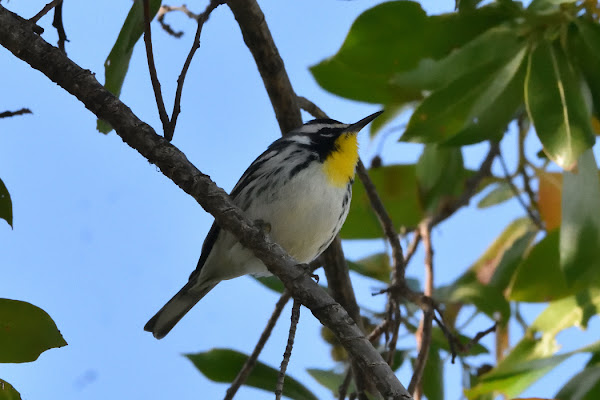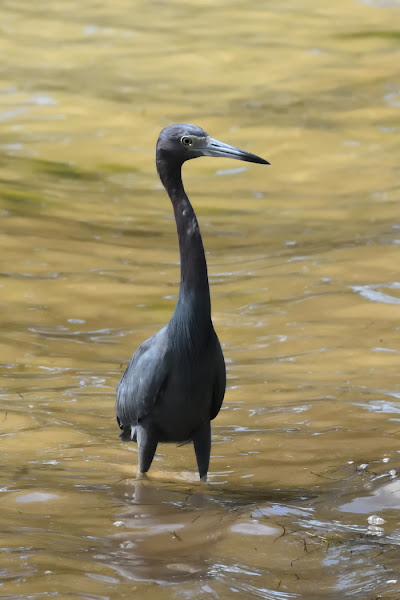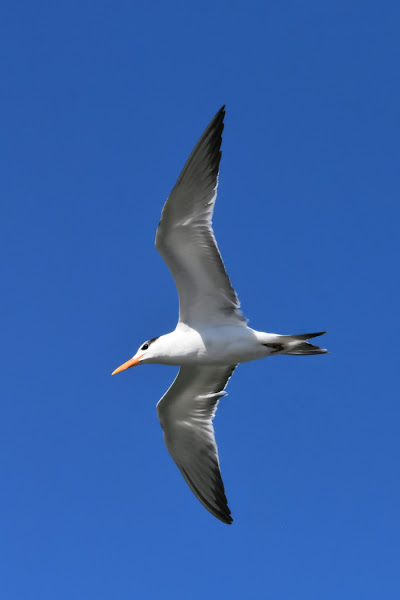I began the day at the Bethlehem landfill. Jason Horn met me there where we both spent the morning checking the thousands of gulls, hoping that the Glaucous-winged Gull might make an appearance. It didn't, but we spotted five different Iceland Gulls there!
While we were there, we found out that a Tufted Duck had been spotted at the Middle Creek Wildlife Management Area in Lancaster County. We drove there and saw the bird among Ring-necked Ducks that were diving in among the large numbers of Snow Geese. I could only get one terrible, long-distant photo of the bird.
On the way back, we stopped in Shartlesville and saw two of the Eurasian Collared-Doves that have been present in that area for several years now.
So although we didn't see the Glaucous-winged Gull, we had a very productive day.
Monday, February 28, 2022
Sunday, February 20, 2022
Glaucous-winged Gull in PA! ~ February 20, 2022
In the late afternoon of February 12th, Jason Hall found and photographed what appeared to be a very good candidate for a Glaucous-winged Gull at Green Lane Reservoir. This gull is normally found on the Pacific Coast. It flew off before anyone else got to see it. I spent the next afternoon along with several other birders hoping that it would return, but it never did.
On the morning of the 20th, Kevin Fox found and photographed a Glaucous-winged Gull on the docks at the Lake Nockamixon marina. There is very little doubt that this was the same bird that was at Green Lane the week before. Apparently, the word didn't get out to the text alerts until the afternoon. At around 2:30, Jason Horn refound the bird again at the marina. I headed out the door and got there around 3:15. Thankfully, the bird was still there resting on the dock. Most of the time, the bird was sleeping with its head tucked in, but there were two times while I was there when a Bald Eagle spooked all of the gulls, causing them to circle around and come back down to the docks. During those brief periods, I was able to get some photos of the bird with its head exposed.
Since I've only seen this bird during trips to the Pacific Northwest and Alaska, I don't have a lot of experience with it, but after looking over my photos, consulting guides, and checking many others' photos plus Jason Hall's from the 12th, this appears to be a second-winter Glaucous-winged Gull, which if accepted by PORC, would represent the first record for Pennsylvania and all of the mid-Atlantic states!
On the morning of the 20th, Kevin Fox found and photographed a Glaucous-winged Gull on the docks at the Lake Nockamixon marina. There is very little doubt that this was the same bird that was at Green Lane the week before. Apparently, the word didn't get out to the text alerts until the afternoon. At around 2:30, Jason Horn refound the bird again at the marina. I headed out the door and got there around 3:15. Thankfully, the bird was still there resting on the dock. Most of the time, the bird was sleeping with its head tucked in, but there were two times while I was there when a Bald Eagle spooked all of the gulls, causing them to circle around and come back down to the docks. During those brief periods, I was able to get some photos of the bird with its head exposed.
Since I've only seen this bird during trips to the Pacific Northwest and Alaska, I don't have a lot of experience with it, but after looking over my photos, consulting guides, and checking many others' photos plus Jason Hall's from the 12th, this appears to be a second-winter Glaucous-winged Gull, which if accepted by PORC, would represent the first record for Pennsylvania and all of the mid-Atlantic states!
Saturday, February 12, 2022
South Florida Trip ~ February 6, 2022
I had been reading the reports of a Zenaida Dove at Long Key State Park in the Florida Keys and was considering flying down there, but I had just done a successful trip to Texas in January, so that initially kept me from going. That changed when Richard Crossley found a Thick-billed Vireo at MacArthur Beach State Park on January 25th and a Yellow-faced Grassquit was photographed on the 28th at the Zenaida Dove spot! Due to other obligations, I was unable to go right away, but I eventually booked a $124.00 round-trip flight to Fort Lauderdale.
On Sunday, the 6th, the alarm went off at 2:30 AM. I left for the Philadelphia Airport, boarded my flight, landed in Fort Lauderdale at around noon, got my rental car, and headed for The Keys. I arrived at Long Key State Park around 3:15 PM and headed down the nature trail to the Zenaida Dove spot. I was a little surprised that I was the only birder there, but many had already been there before to see it. I spent over two hours there with no sign of the dove. A few Magnificent Frigatebirds soared overhead among the large numbers of Turkey Vultures.
At around 5:30, with sunset approaching, I finally saw the Zenaida Dove perched on a fairly horizontal trunk that I had searched many times before. It spent the next 25 minutes there, allowing me to get some nice photos of it as the sunlight waned. Note the small white wing patch and the short tail. The purple patch on its neck also showed nicely, depending on the angle.
On the way back out to the car, a Yellow-crowned Night-Heron was standing along the boardwalk bridge.
I left there with a 'lifer' and headed to the Sunset Inn in Islamorada.
On Sunday, the 6th, the alarm went off at 2:30 AM. I left for the Philadelphia Airport, boarded my flight, landed in Fort Lauderdale at around noon, got my rental car, and headed for The Keys. I arrived at Long Key State Park around 3:15 PM and headed down the nature trail to the Zenaida Dove spot. I was a little surprised that I was the only birder there, but many had already been there before to see it. I spent over two hours there with no sign of the dove. A few Magnificent Frigatebirds soared overhead among the large numbers of Turkey Vultures.
At around 5:30, with sunset approaching, I finally saw the Zenaida Dove perched on a fairly horizontal trunk that I had searched many times before. It spent the next 25 minutes there, allowing me to get some nice photos of it as the sunlight waned. Note the small white wing patch and the short tail. The purple patch on its neck also showed nicely, depending on the angle.
On the way back out to the car, a Yellow-crowned Night-Heron was standing along the boardwalk bridge.
I left there with a 'lifer' and headed to the Sunset Inn in Islamorada.
South Florida Trip ~ February 7, 2022
With the Zenaida Dove already 'in the bag', I had another whole day to spend on The Keys, so I headed back to Long Key State Park hoping to find the Yellow-faced Grassquit. It had only been seen one day and not since, so it was a long shot, but I had nothing to lose by trying. I headed back down the nature trail where a Great Crested Flycatcher was giving its 'weep' calls.
A Yellow-throated Warbler flitted around in one of the trees and a Prairie Warbler found and gobbled down a few spiders trying to hide in some leaves.
A five-foot-long Black Rat Snake stretched all the way across the trail near where a Little Blue Heron worked the shoreline.
I decided to take a break from the heat of the day, so I drove south to the Overseas Heritage Highway pulloff at the bridge on Conch Key. There, I found Willet, Spotted Sandpiper, Double-crested Cormorant, Brown Pelican, Royal Tern, and a Great "White" Heron (the white form of Great Blue Heron).
I stopped and ate at an outdoor bar and returned to Long Key State Park around 3:00. A pretty large Iguana was in the gumbo limbo tree at 'the bench'. A Black-and-white Warbler surveyed the branches while a Northern Parula was conveniently feeding at eye level.
It was now near sunset and there still was no sign of the Yellow-faced Grassquit, so I headed back out to the car. Along the way, I saw Wood Stork, Great "White" Heron, and Yellow-crowned Night-Heron. I got a pizza and spent my last night at the Sunset Inn.
A Yellow-throated Warbler flitted around in one of the trees and a Prairie Warbler found and gobbled down a few spiders trying to hide in some leaves.
A five-foot-long Black Rat Snake stretched all the way across the trail near where a Little Blue Heron worked the shoreline.
I decided to take a break from the heat of the day, so I drove south to the Overseas Heritage Highway pulloff at the bridge on Conch Key. There, I found Willet, Spotted Sandpiper, Double-crested Cormorant, Brown Pelican, Royal Tern, and a Great "White" Heron (the white form of Great Blue Heron).
I stopped and ate at an outdoor bar and returned to Long Key State Park around 3:00. A pretty large Iguana was in the gumbo limbo tree at 'the bench'. A Black-and-white Warbler surveyed the branches while a Northern Parula was conveniently feeding at eye level.
It was now near sunset and there still was no sign of the Yellow-faced Grassquit, so I headed back out to the car. Along the way, I saw Wood Stork, Great "White" Heron, and Yellow-crowned Night-Heron. I got a pizza and spent my last night at the Sunset Inn.
South Florida Trip ~ February 8, 2022
My next target bird was the Thick-billed Vireo on the mainland near North Palm Beach, which was about a 3-1/2-hour drive from Islamorada. I wanted to get there in the morning, so I got up real early in order to miss most of the rush-hour traffic in The Keys and Miami area. There were several slow-downs along the way, but I got to John D. MacArthur Beach State Park at 9:30. I started searching the U-shaped parking lot where the bird had most often been seen. About a half-hour later, an SUV parked next to my car and Richard Crossley and Holly Merker got out! Richard was the one who had originally found the bird back on January 25th. It was totally bizarre that we happened to show up at that spot on the same morning. The three of us searched for the bird and, not surprisingly, Richard spotted the Thick-billed Vireo among a Blue-headed Vireo, a Northern Parula, and a few Blue-gray Gnatcatchers. It was a great relief to see this bird since the area was densely forested and it probably would have been tough to find it on my own. The bird stayed near the top of the trees, making it difficult to get photos, but I was lucky to get several fairly in-focus photos of the distinctive facial pattern. Note the yellow lores in front of a dark eye with an eye ring that encircles only the back half of the eye.
I walked out the boardwalk to the beach area of the park. A few Sanderlings and Ruddy Turnstones were feeding in the wrack line.
Two Piping Plovers were also there. One had a green tag on its left leg that read "EAH", but I was unable to get a photo of it before a beach walker scared it off.
A long line of gulls stretched along the Atlantic Ocean shoreline, including about 175 Lesser Black-backed Gulls, 100 Herring Gulls, and 2 Ring-billed Gulls.
A Northern Gannet floated pretty far offshore and eventually flew off to the north.
From the park, I drove to Palm Beach Lakes where I would spend the next three nights at the Best Western.
I walked out the boardwalk to the beach area of the park. A few Sanderlings and Ruddy Turnstones were feeding in the wrack line.
Two Piping Plovers were also there. One had a green tag on its left leg that read "EAH", but I was unable to get a photo of it before a beach walker scared it off.
A long line of gulls stretched along the Atlantic Ocean shoreline, including about 175 Lesser Black-backed Gulls, 100 Herring Gulls, and 2 Ring-billed Gulls.
A Northern Gannet floated pretty far offshore and eventually flew off to the north.
From the park, I drove to Palm Beach Lakes where I would spend the next three nights at the Best Western.
South Florida Trip ~ February 9, 2022
After seeing both the dove and the vireo, my plan was to drive to Torry Island near Belle Glade and look for the Tricolored Munias. Rain persisted throughout most of the morning, so I took a nap in the car in the parking lot until it let up. Two Limpkins, a Cattle Egret, and two Gray-headed Swamphens were feeding nearby.
At around 11 AM, I walked out the path towards the observation tower. Although it was pretty windy, I spotted a few Painted Buntings, Indigo Bunting, and a female Blue Grosbeak along with Common Yellowthroat and numerous Palm Warblers. The Painted Buntings have to be the most colorful songbird in the country.
Birds seen over the marshy area from the observation tower included Common and Purple Gallinule, Snowy Egret, Green Heron, Northern Harrier, Red-shouldered Hawk, and a distant Snail Kite with a band on its left leg.
Just southwest of the observation tower were the continuing male Vermilion Flycatcher and the Tropical Kingbird.
While attempting to take a photo of the Tropical Kingbird, the Vermilion Flycatcher 'photobombed' it. The flycatcher isn't in focus, but the fact that both of these species are in the same frame is amazing.
The lake area produced American Coot, a 'fly-by' Royal Tern, Anhinga, Brown Pelican, Great Egret, White Ibis, and Osprey. Not finding the munias, I decided to drive into the nearby town of Belle Glade and get something to eat. By the time I returned to Torry Island, the skies had brightened considerably and the winds had died down. A Loggerhead Shrike perched on a sign at the parking lot and Boat-tailed Grackles showed off their glossy colors.
Two Common Ground Doves fed just beyond the observation tower with a few Mourning Doves, allowing for a great comparison of the two.
While watching the edge of the reeds, I happened to notice something tiny and tan-colored move near the bee box between the last bench and the observation tower. I quickly got my binoculars on it and realized that it was one of the Tricolored Munias. Right after that, a second bird joined it and the two birds proceeded to methodically feed around all sides of the tower. They spent most of their time next to the tower, feeding on seeds in the grass between the path and the lake shore's corner. There, they showed off their silvery-blue bills, tiny tails, and overall small size.
After watching them for about a half-hour, I happily walked back to the car and returned to the Best Western in Palm Beach Lakes for the night.
At around 11 AM, I walked out the path towards the observation tower. Although it was pretty windy, I spotted a few Painted Buntings, Indigo Bunting, and a female Blue Grosbeak along with Common Yellowthroat and numerous Palm Warblers. The Painted Buntings have to be the most colorful songbird in the country.
Birds seen over the marshy area from the observation tower included Common and Purple Gallinule, Snowy Egret, Green Heron, Northern Harrier, Red-shouldered Hawk, and a distant Snail Kite with a band on its left leg.
Just southwest of the observation tower were the continuing male Vermilion Flycatcher and the Tropical Kingbird.
While attempting to take a photo of the Tropical Kingbird, the Vermilion Flycatcher 'photobombed' it. The flycatcher isn't in focus, but the fact that both of these species are in the same frame is amazing.
The lake area produced American Coot, a 'fly-by' Royal Tern, Anhinga, Brown Pelican, Great Egret, White Ibis, and Osprey. Not finding the munias, I decided to drive into the nearby town of Belle Glade and get something to eat. By the time I returned to Torry Island, the skies had brightened considerably and the winds had died down. A Loggerhead Shrike perched on a sign at the parking lot and Boat-tailed Grackles showed off their glossy colors.
Two Common Ground Doves fed just beyond the observation tower with a few Mourning Doves, allowing for a great comparison of the two.
While watching the edge of the reeds, I happened to notice something tiny and tan-colored move near the bee box between the last bench and the observation tower. I quickly got my binoculars on it and realized that it was one of the Tricolored Munias. Right after that, a second bird joined it and the two birds proceeded to methodically feed around all sides of the tower. They spent most of their time next to the tower, feeding on seeds in the grass between the path and the lake shore's corner. There, they showed off their silvery-blue bills, tiny tails, and overall small size.
After watching them for about a half-hour, I happily walked back to the car and returned to the Best Western in Palm Beach Lakes for the night.
Subscribe to:
Comments (Atom)




























































